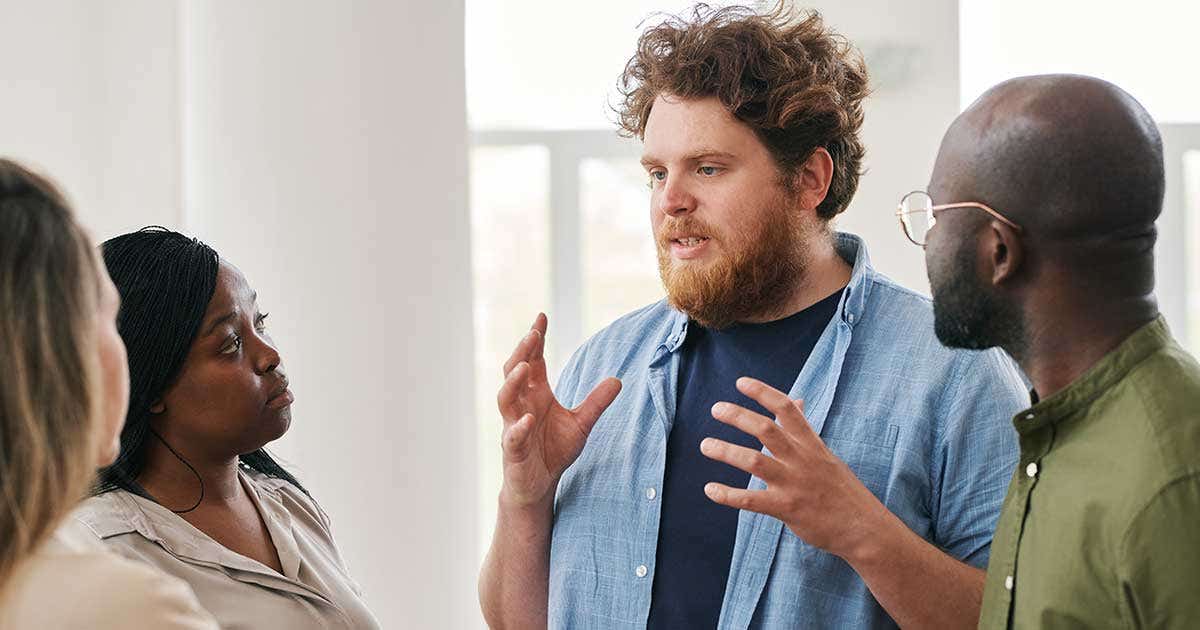Hand gestures make talking easier to follow, study finds
New brain research shows hand gestures help listeners predict upcoming words in speech—even before they’re spoken.

Study finds hand gestures help the brain predict speech, making communication faster and easier. (CREDIT: Shutterstock)
When people talk face to face, they don’t rely on words alone. They move their hands, raise their eyebrows, or nod to help express what they mean. These gestures often carry meaning and help listeners understand spoken language faster. But recent research shows they may do even more. Scientists from the Max Planck Institute for Psycholinguistics have now found that hand gestures help people predict what someone is going to say next—even before the speaker finishes their sentence.
What Your Brain Sees Before It Hears
Think about a person talking about computers. They might wiggle their fingers in the air like they’re typing. That simple movement, known as an iconic gesture, gives a clear hint about what word might be coming. If someone says, “How old were you when you learned to…” and moves their hands like they’re typing, your brain is already thinking of the word “type” before it’s even spoken.
That’s exactly what researchers wanted to test. They ran two detailed experiments using virtual avatars to see how gestures affect the brain during conversation. The study took place at a top language research institute, where scientists worked to understand how our minds handle both speech and movement during communication.
The lead researcher, Marlijn ter Bekke, explains: “We already know that questions produced with iconic gestures get faster responses in conversation.” What she and her team wanted to discover was how gestures help people respond more quickly.
The Power of Prediction
In the first experiment, people watched a lifelike avatar ask simple questions like, “How old were you when you learned to…” and then stop. Right before the pause, the avatar either made a typing gesture, scratched its arm (which has no meaning), or didn’t move at all. Participants had to guess how the question would finish.
The results were clear. People were far more likely to correctly guess the missing word—like “type”—when they had seen a meaningful hand gesture before the pause. Even though the actual word wasn’t spoken yet, the gesture helped them figure it out. This showed that gestures aren’t just nice extras in conversation—they actually help predict language in real time.
Related Stories
How Your Brain Reacts
The second experiment dug deeper. This time, the researchers recorded brain activity while participants listened to the full questions. As before, the avatars made either meaningful gestures, random movements, or no gestures at all. Electroencephalography, or EEG, measured the brain’s electrical signals throughout the task.
The brainwaves told an exciting story. During the pause—before the final word was spoken—researchers saw a drop in alpha and beta wave activity when participants had seen a meaningful gesture. These waves are known to relate to attention and anticipation. This change showed that the brain was actively preparing for the upcoming word, thanks to the gesture.
After the word was finally spoken, scientists saw a smaller N400 response in the brain. The N400 is a well-known brain signal that lights up when people process a word that doesn’t quite make sense in a sentence. A smaller N400 means the brain had an easier time understanding the word. This confirmed that gestures help listeners process speech more smoothly.
“These results show that even when participants are just listening, they use gestures to predict what someone might say next,” said Ter Bekke.
What This Means for Future Communication
This research does more than show that gestures help you understand speech. It also reveals just how deeply connected body movement and language really are. Gestures and words work together as one system. The brain doesn’t just wait for words—it uses every clue it can get, including hand movements, to figure out what’s coming next.
Even more impressive, the study used avatars—computer-generated characters—rather than real people. That means your brain can read and respond to gestures, even when they come from something that isn’t human.
“Our study shows that even gestures produced by a virtual avatar facilitate language processing,” Ter Bekke said. “If we want artificial agents, like robots or virtual avatars, to be readily understood, and in a human-like way, they should not only communicate with speech, but also with meaningful hand gestures.”
This finding is especially important as machines become part of everyday life. Whether it's a talking robot at the airport or a virtual assistant on your phone, future tech could feel more natural and human if it includes meaningful gestures, not just voices.
The Science of Understanding
The experiments also show why studying the brain in natural conversation settings matters. Language doesn’t happen in a vacuum. People speak with their bodies, not just their mouths. When gestures are included in studies of speech, researchers get a more complete picture of how language really works.
This study adds strong support to the idea that human communication is multimodal. That means it involves many types of signals—words, tone, movement, and more—all working together. It also challenges older theories that focus on spoken words alone.
Thanks to this research, scientists now know that gestures are more than add-ons to speech. They are predictive cues that the brain actively uses. They help you not just understand, but anticipate what’s being said.
So next time you watch someone talk with their hands, remember—your brain is already one step ahead.
Research findings are available online in the journal Psychological Science.
Note: The article above provided above by The Brighter Side of News.
Like these kind of feel good stories? Get The Brighter Side of News' newsletter.



